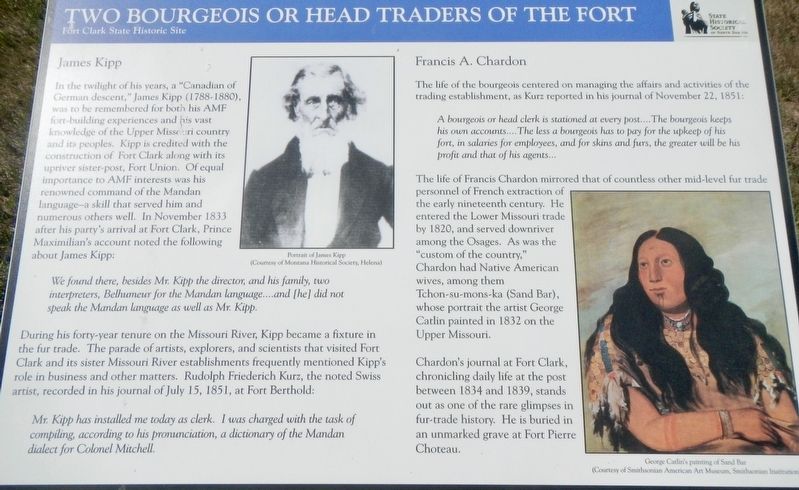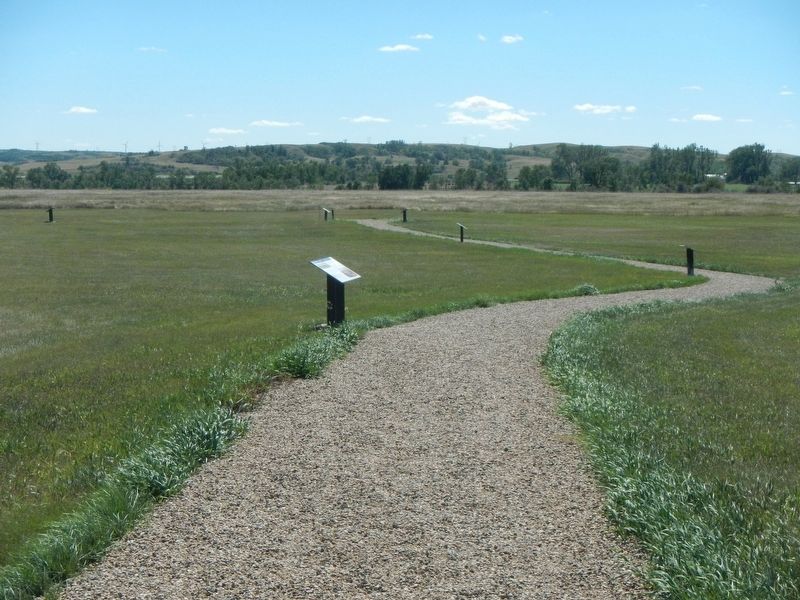Near Stanton in Mercer County, North Dakota — The American Midwest (Upper Plains)
Two Bourgeois or Head Traders of the Fort
Fort Clark State Historic Site
Inscription.
James Kipp
In the twilight of his years, a "Canadian of German descent," James Kipp, (1788-1880_ was to be remembered for both his AMF fort-building experiences and his vast knowledge of the Upper Missouri country and its people. Kipp is credited with the construction of Fort Clark along with its upriver sister-post Fort Union. Of equal importance to AMF interests was his renowned command of the Mandan language-a skill that served him and numerous others well. In November 1933 after his party's arrival at Fort Clark, Prince Maximilian's account noted the following about James Kipp:
We found there, besides Mr. Kipp the director, and his family, two interpreters, Belhumeur for the Mandan language....and (he) did not speak the Mandan language as well as Mr. Kipp.
During his forty-year tenure on the Missouri River, Kipp became a fixture in the fur trade. The parade of artists, explorers, and scientists that visited Fort Clark and its sister Missouri River establishments frequently mentioned Kipp's role in business and other matters. Rudolph Friederich Kurz, the noted Swiss artist, recorded in his journal of July 15, 1851, at Fort Berthold:
Mr. Kipp has installed me today as clerk. I was charged with the task of compiling, according to his pronunciation, a dictionary of the Mandan dialect for Colonel Mitchell.
Francis A. Chardon
The life of the bourgeois centered on managing the affairs and activities of the trading establishment, as Kurz reported in his journal of November 22, 1851.
A bourgeois or head clerk is stationed at every post....The bourgeois keeps his own accounts....The less a bourgeois has to pay for the upkeep of his fort, in salaries for employees, and for skins and furs, the greater will be his profit and that of his agents....
The life of Francis Chardon mirrored that of countless other mid-level fur trade personnel of French extraction of the early nineteenth century. He entered the Lower Missouri trade by 1820, and served downriver among the Osages. As was the "custom of the country," Chardon had Native American wives, among them Tchon-su-mons-ka (Sandy Bar), whose portrait artist George Catlin painted in 1832 on the Upper Missouri.
Chardon's journal at Fort Clark, chronicling daily life at the post between 1834 and 1839, stands out as one of the rare glimpses in fur-trade history. He is buried in an unmarked grave at Fort Pierre Choteau.
Erected by State Historical Society of North Dakota.
Topics. This historical marker is listed in this topic list: Industry & Commerce.
Location.
47° 15.035′ N, 101° 16.355′ W. Marker is near Stanton, North Dakota, in Mercer County. Marker is on 37th Avenue Southwest near 12th Street Southwest (State Highway 200). The marker is located at the Fort Clark State Historic Site. Touch for map. Marker is in this post office area: Stanton ND 58571, United States of America. Touch for directions.
Other nearby markers. At least 8 other markers are within walking distance of this marker. Geophysics and Archaeology (here, next to this marker); The Blockhouses (here, next to this marker); Trading Post Plan (here, next to this marker); Pierre Garreau's Lodge (within shouting distance of this marker); Fort Clark (circa 1830-1860) (about 300 feet away, measured in a direct line); The People (about 300 feet away); Missouri Valley Environs (about 500 feet away); Winter Villages and Lodges (about 500 feet away). Touch for a list and map of all markers in Stanton.
Also see . . . James Kipp -- Mountain Men and Life in the Rocky Mountain West. Kipp served as factor at a number of posts for relatively brief periods of time. He was also responsibly for bringing furs and skins down river by barge and mackinaw boat to St. Louis. (Submitted on December 13, 2020, by Barry Swackhamer of Brentwood, California.)
Credits. This page was last revised on December 13, 2020. It was originally submitted on December 13, 2020, by Barry Swackhamer of Brentwood, California. This page has been viewed 156 times since then and 13 times this year. Photos: 1, 2. submitted on December 13, 2020, by Barry Swackhamer of Brentwood, California.

